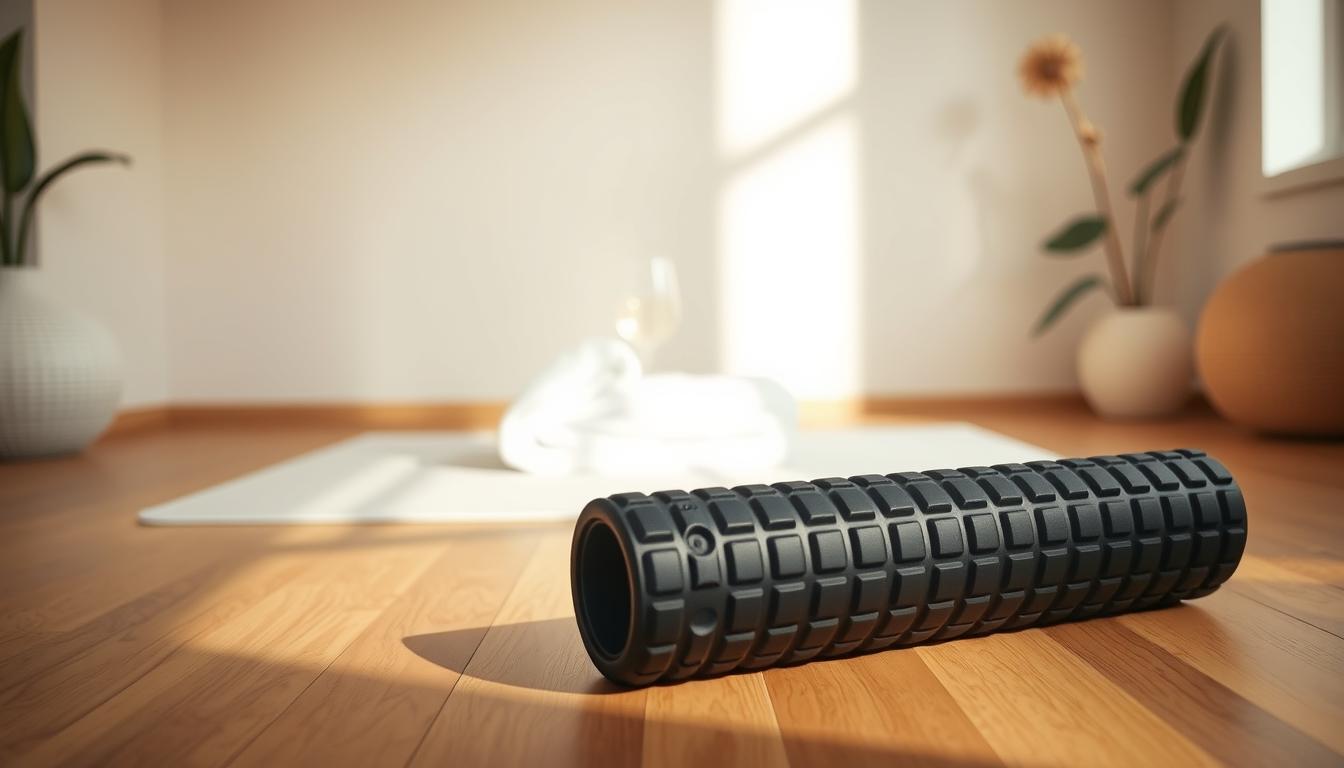With today’s fast work life, many people sit a lot. This can lead to neck and shoulder pain. To help, try doing seated neck stretches every day. These stretches are made for office settings. They let you relax your neck right at your desk. Keeping your neck healthy with these easy stretches can make you feel better. It also keeps you productive.
Understanding Neck Pain and Its Causes
Neck pain can come from many things that people face every day. A big cause is not moving much, which makes the neck stiff and sore. Studies find that lots of American workers often have neck and shoulder pain. This is mainly from sitting too long at desks, doing the same motions, and not sitting right.
It’s key to see how these factors are linked to tackle neck pain well.
The Impact of Sedentary Lifestyles
Not moving much plays a big role in neck pain. Sitting too long can make muscles and joints stiff. This lack of activity can lead to tightness and pain in the neck. Moving around and stretching often can help ease this pain.
Common Posture Problems at Desk Jobs
Bad posture is another main cause of neck pain. Many people slouch or lean too close to their screens when they work. Such bad habits up the pressure on the neck. Sitting the right way helps lessen pain and stop worse problems later.
Benefits of Regular Neck Stretching
Regular neck stretching brings many health benefits. Adding simple stretches to your daily life improves neck flexibility. This helps you do better in all kinds of activities. Stretches make it easier to move and help lower stress. They also keep chronic pain away.
Improved Flexibility and Range of Motion
Stretching your neck often boosts its flexibility and how much you can move it. Being more flexible lets you turn and tilt your head without feeling pain. As muscles stretch and become longer, stiffness lessens. This makes your neck more flexible and easy to move.
Reduction of Stress and Tension
Doing neck stretches every day helps reduce stress and tension in your neck and shoulders. Focusing on these areas helps you relax, which is good for your mind and feelings. Adding stretches to your workday gives you a break and boosts your wellness.
Prevention of Chronic Pain
Stretching regularly is a good way to avoid chronic neck pain. It keeps your neck flexible and reduces muscle tightness. This can help prevent injuries, especially from sitting at a desk too much. Keeping your neck in good shape helps you stay productive all day.
Seated Neck Stretches You Can Do at Your Desk
Adding stretches to your workday helps with neck tension and increases comfort. Here are three simple neck stretches you can do at your desk every day.
Chin Tuck Stretch
The chin tuck stretch fights against bad posture caused by leaning forward. To do it, sit straight in your chair. Gently lower your chin to your chest, keeping your shoulders relaxed. Hold this for 15 to 30 seconds, feeling the stretch in the back of your neck.
Side Neck Stretch
To loosen the sides of your neck, start by sitting up straight. Tilt your head towards one shoulder without raising that shoulder. Hold for 15 to 30 seconds to ease tension on the neck’s opposite side. Then, do the same on the other side.
Neck Rotation Stretch
This stretch makes your neck more flexible and less stiff. Sit in a comfortable position and slowly turn your head to one side. You should feel a light stretch. Stay like this for a bit, then switch to the other side. Each side should be held for 15 to 30 seconds.
Additional Desk-Friendly Stretches for Overall Relief
Adding simple stretches to your day can make work more comfortable. Besides neck stretches, these two exercises help ease tension. They make you less stiff and more flexible.
Shoulder Shrugs
Shoulder shrugs help loosen up your upper body. Here’s how to do them:
- Sit or stand, keeping your arms relaxed at your sides.
- Inhale deeply, lifting your shoulders up towards your ears.
- Hold for a few moments, then exhale and lower them back down.
Doing shoulder shrugs can improve your posture and reduce neck tension.
Forward Arm Stretch
The forward arm stretch stretches your arms and boosts flexibility. Here are the steps:
- Sit straight at your desk.
- Extend your arms in front, palms facing each other.
- Keep this pose for 15 to 30 seconds, feeling the stretch across your shoulders.
This stretch helps fight stiffness and makes working at a desk more bearable.
How to Integrate Stretches into Your Workday
Mixing regular stretches into your day can boost comfort and work efficiency big time. If you’re sitting at a desk for hours, it’s crucial to stretch often. Here’s how to make sure you do it every day.
Setting a Reminder System
Using reminders helps remember when it’s time to stretch. Smartphones and apps are great for setting these alerts. Here’s what to keep in mind for your reminders:
- Pick times that fit your schedule, like every 30 to 60 minutes.
- Use fun sounds or quotes to make reminders interesting.
- Customize them so they feel special to you.
Creating an Ergonomic Workspace
An ergonomic setup helps you feel better and stretch easily during the day. To make your workspace better, focus on these things:
- Adjust your desk and chair to the right height.
- Keep your computer screen at eye level to avoid neck pain.
- Choose chairs that are comfy and support your posture.
Tips for Effective Stretching
Effective stretching combines proper technique with body awareness. Knowing how to breathe right and paying attention to your body makes stretching more effective. It also keeps you safe.
Proper Breathing Techniques
Breathing right is key to improving your stretching. Begin by taking a deep breath to fill your lungs with air. This increases the amount of oxygen in your body.
As you stretch further, breathe out slowly. This helps your body relax more. Using this breathing method helps you be more aware of your body. It can also lead to safer and better stretching results.
Listening to Your Body
Listening to your body is crucial when stretching. Pay attention to how you feel during the exercises. If something hurts, you might need to change how you’re moving.
Stretches should feel slightly uncomfortable but never painful. This is important to prevent injuries. Understanding what your body is telling you makes your stretching more effective.
Myths about Stretching and Neck Pain
It’s important to understand myths about stretching for neck pain relief. Many people think all stretches are good for everyone. But, this isn’t always true. Some stretching methods can make neck pain worse. By knowing these myths, you can choose the best stretches for your neck.
Debunking Common Misconceptions
There are many wrong ideas about stretching out there. One misconception is that neck circles can ease tension. However, for those with certain neck issues, this might not be a good idea. Learning the truth about stretching helps you make smarter choices for easing pain. Keep these points in mind:
- Not all stretches are suitable for everyone.
- Dynamic stretches may aggravate certain neck conditions.
- Gentle, static stretches often yield better results.
Real-Life Testimonials and Studies on Stretching
Looking into stretching at work, we find strong stories and data that back up how good it is. Many workers have talked about the big positives, showing the advantages of small stretch breaks. These include less tension and more productivity, thanks to regular stretching right at their desks.
Employee Experiences with Desk Stretches
Many workers have shared how desk stretches made them feel better. They’ve noticed they move easier and don’t get neck pain as much after stretching during the day. These stories remind us that simple actions can make a big difference in tough job settings. People often say they feel:
- More flexible and can move easier.
- Fewer headaches and less severe ones.
- More focused and clear-headed while working.
Research Findings Supporting Workplace Stretching
Studies match what employees have said they feel. The data confirms that stretching often can really make our range of motion better and cut down pain by up to 72%. These findings help argue for more stretching programs at work. They add solid proof to the discussions about the benefits of stretching in the workplace.
Preventing Neck Pain Beyond Stretching
Stopping neck pain isn’t only about stretching. Good posture and ergonomic tools at your desk can greatly improve comfort and health. It’s important to sit properly to avoid straining your neck and spine.
Adopting Good Posture Practices
Keeping good posture is key to avoid neck pain. You should keep your head straight above your spine and shoulders level. Place your screens at eye height to avoid bending your neck. Also, sitting with your feet flat helps keep your posture balanced and lessens neck tension.
Utilizing Ergonomic Tools
Using ergonomic tools can make your desk setup better and support good posture. Chairs that adjust give you the right height and back support. Sit-stand desks let you move around, which is good for you. These tools create a nicer work space, cut down on neck pain, and boost overall health.

Conclusion
Adding stretches suited for the desk to your daily routine is key for a healthier workplace and less neck pain. Doing these neck stretches often can greatly boost your overall health. This way of looking after your neck not only cuts down pain but also ups your work output and concentration.
There’s growing knowledge about keeping well at work, urging companies to have programs focused on stretching and using good desk setups. Such steps lead to a work space that’s better for everyone’s health, benefiting staff and business owners.
Understanding the role of stretches you can do while seated and staying in good posture is vital. It leads to better neck health, especially when most work is done sitting down. Adding these easy routines can really help in keeping comfy all day at work.



